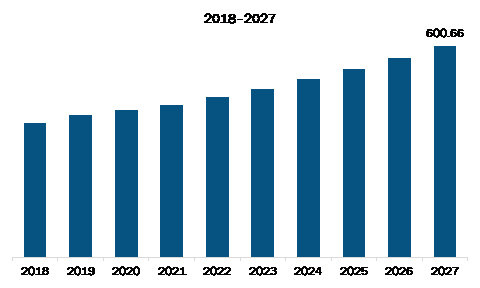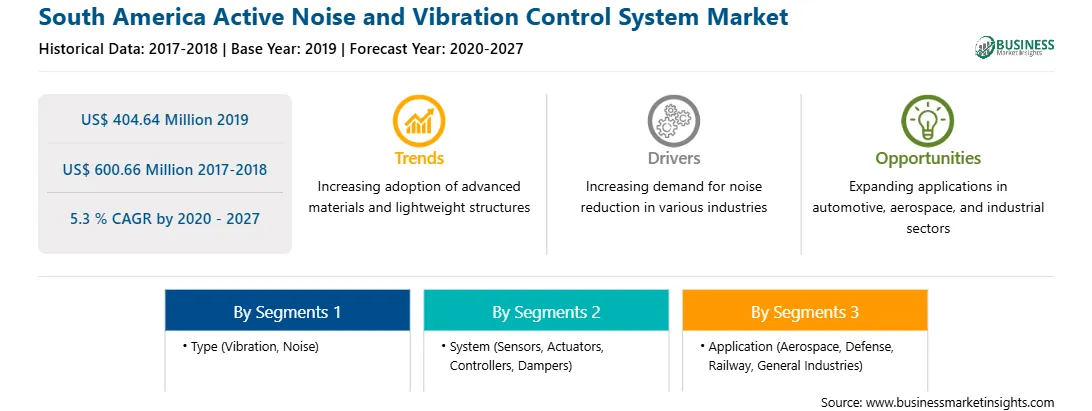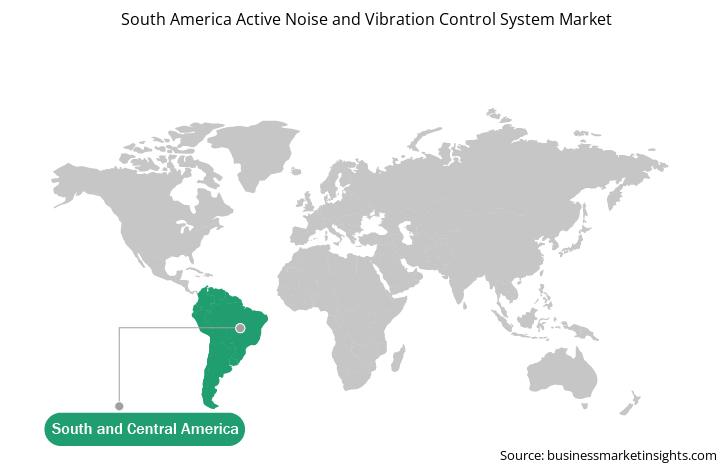South America Active Noise and Vibration Control System Market
No. of Pages: 89 | Report Code: TIPRE00014159 | Category: Aerospace and Defense
No. of Pages: 89 | Report Code: TIPRE00014159 | Category: Aerospace and Defense
The SAM aircraft manufacturing industry is experiencing substantial growth due to the increasing demand for commercial aircraft. The growing disposable incomes in SAM countries and the presence of top players such as Boeing and Airbus are some of the factors that are driving the demand of these aircraft. In a SAM scenario, commercial aircraft are anticipated to maintain a continuous growth over the coming years, regardless of several challenges faced by the commercial airlines such as uncertain fuel prices and other regulatory changes in various countries. The growing production of aircraft, demands the integration of advanced equipment such as anti-vibration and noise control systems, to offer smooth journey experience to the passengers. The latest aircraft fly at different altitudes that produce noise and vibrations of different levels. The passive noise and vibration control systems are ineffective in reducing a considerable percentage of the noise and passenger and create inconvenience to the passenger during their journey. Thus, the use of smaller, lightweight components to reduce noise and vibrations in the cabin as well as the cockpit are integrated into active systems, which efficiently reduce both noise, vibration and weight of the aircraft. This factor is attracting significant number of aircraft OEMs and component OEMs, which is catalyzing the SAM active noise and vibration control system market. Factor like accentuating attention into aircraft weight reduction is expected to create a significant demand for active noise and vibration control system in the coming years, which is further anticipated to drive the SAM market. Furthermore, in case of COVID-19, Brazil has the highest number of COVID-19 cases in SAM region. Brazil is the largest spender in the aerospace industry and is the only modern aircraft manufacturing country in the region. Owing to this, the demand for components and parts is an all-time high in the country. The slowdown in the production of commercial and military aircraft in the country has impaired the supply chain in Brazil. This has weakened the demand for several components, including active noise and vibration control systems. Thus, the outbreak of COVID-19 has had a harsh impact on SAM active noise and vibration control system market, especially in Brazil.

Strategic insights for the South America Active Noise and Vibration Control System provides data-driven analysis of the industry landscape, including current trends, key players, and regional nuances. These insights offer actionable recommendations, enabling readers to differentiate themselves from competitors by identifying untapped segments or developing unique value propositions. Leveraging data analytics, these insights help industry players anticipate the market shifts, whether investors, manufacturers, or other stakeholders. A future-oriented perspective is essential, helping stakeholders anticipate market shifts and position themselves for long-term success in this dynamic region. Ultimately, effective strategic insights empower readers to make informed decisions that drive profitability and achieve their business objectives within the market.

| Report Attribute | Details |
|---|---|
| Market size in 2019 | US$ 404.64 Million |
| Market Size by 2027 | US$ 600.66 Million |
| Global CAGR (2020 - 2027) | 5.3 % |
| Historical Data | 2017-2018 |
| Forecast period | 2020-2027 |
| Segments Covered |
By Type
|
| Regions and Countries Covered | South and Central America
|
| Market leaders and key company profiles |
The geographic scope of the South America Active Noise and Vibration Control System refers to the specific areas in which a business operates and competes. Understanding local distinctions, such as diverse consumer preferences (e.g., demand for specific plug types or battery backup durations), varying economic conditions, and regulatory environments, is crucial for tailoring strategies to specific markets. Businesses can expand their reach by identifying underserved areas or adapting their offerings to meet local demands. A clear market focus allows for more effective resource allocation, targeted marketing campaigns, and better positioning against local competitors, ultimately driving growth in those targeted areas.

The active noise and vibration control system market in SAM is expected to grow from US$ 404.64 million in 2019 to US$ 600.66 million by 2027; it is estimated to grow at a CAGR of 5.3 % from 2020 to 2027.Growing adoption of active systems in railway manufacturing will push the demand of active noise and vibration control systems in SAM. The railway industry across the SAM is growing at a considerable rate over the years, with several on-going technological advancements reflecting safer and comfortable journeys. The railway equipment (bogies and load carts) experience significant vertical vibrations and noise, which increase several types of risk while in operations. To suppress the vibrations and noise, several railway equipment manufacturers are increasingly focusing on the adoption of noise and vibration control systems. An active system with inertial mass actuators mounted on the bogies can control low frequency noise and vibrations inside the compartments. In addition, the active systems are generally electromechanical systems, which is the becoming the key preference among the railway equipment manufacturers. This factor is expected to generate significantly higher demand for active systems among the railway equipment manufacturers, thereby catalyzing the SAM active noise and vibration control system market.
In terms of type, the vibration segment accounted for the largest share of the SAM active noise and vibration control system market in 2019. In terms of system, the actuators segment held a larger market share of the SAM active noise and vibration control system market in 2019. Further, the aerospace segment held a larger share of the market based on application in 2019.
A few major primary and secondary sources referred for preparing this report on active noise and vibration control system market in SAM are company websites, annual reports, financial reports, national government documents, and statistical database, among others. Major companies listed in the report are Faurecia Creo AB; Honeywell International Inc.; Hutchinson; Moog Inc.; Parker Hannifin Corporation; Trelleborg AB.
The List of Companies - South America Active Noise and Vibration Control System Market
The South America Active Noise and Vibration Control System Market is valued at US$ 404.64 Million in 2019, it is projected to reach US$ 600.66 Million by 2027.
As per our report South America Active Noise and Vibration Control System Market, the market size is valued at US$ 404.64 Million in 2019, projecting it to reach US$ 600.66 Million by 2027. This translates to a CAGR of approximately 5.3 % during the forecast period.
The South America Active Noise and Vibration Control System Market report typically cover these key segments-
The historic period, base year, and forecast period can vary slightly depending on the specific market research report. However, for the South America Active Noise and Vibration Control System Market report:
The South America Active Noise and Vibration Control System Market is populated by several key players, each contributing to its growth and innovation. Some of the major players include:
The South America Active Noise and Vibration Control System Market report is valuable for diverse stakeholders, including:
Essentially, anyone involved in or considering involvement in the South America Active Noise and Vibration Control System Market value chain can benefit from the information contained in a comprehensive market report.